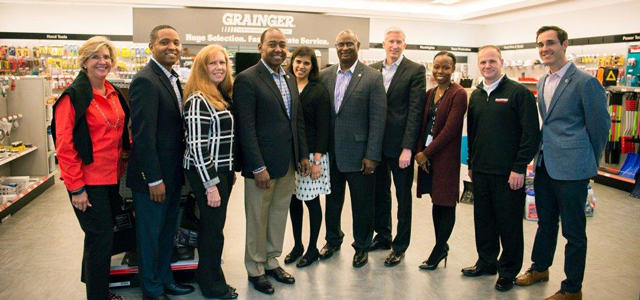Photo: DG Macpherson, Chairman of the Board & Chief Executive Officer, Grainger, Joseph C. High, Senior Vice President & Chief People Officer, Grainger, Stuart L. Levenick, Lead Director, Grainger Board of Directors
Preparing for change of leadership in a company is essential to the long-term success of the organization. The succession process for the role of Chief Executive Officer for large corporations impacts internal and external stakeholders in meaningful ways.
Defining who will take the helm requires much more than selecting candidates and an interview. The best stewardship and governance requires a planned and scheduled departure of the CEO. The skill needed to balance the expectations of the board of directors, internal leaders – and in some cases the incoming and outgoing CEOs – requires a strong partnership with executive human resource leadership, a corporate governance lens usually provided by the General Counsel (GC), and an aligned focus on the big picture.
A 2014 Stanford University study entitled, “Seven Myths of CEO Succession” (Larcker, Miles & Tayan) identifies four general approaches to selecting a CEO: CEO-in-Waiting, Internal Development, External Recruit and the Inside Out Approach (the company combines an internal development plan with external candidate selection). The circumstances of the transition influence the approach.

Joseph C. High, Senior Vice President & Chief People Officer, Grainger
Joseph C. High, Senior Vice President and Chief People Officer for Grainger, is deeply qualified in succession planning strategy and execution; he has contributed to the placement of three CEOs of major corporations, the latest at Grainger, a Fortune 500 distributor of facility maintenance products.
High started his career as a first line leader in a manufacturing plant. Line experience gave him an opportunity to learn the business from the bottom up. This foundational work also taught him how to manage a large group of people with more experience in the business and the criticality of people development. High leveraged this field experience to ascend to HUMAN RESOURCE leadership and gain experience working at the headquarters level across multiple industries and business cycles.
Grainger’s board’s selection of the company’s current CEO, D.G. Macpherson provides an impactful model and reinforces eight lessons High has learned over the span of his career.
Succession Planning:
- Is owned by the board of directors, and shared with executives
- Begins and ends with company purpose and strategy
- Is a journey, not an event
- Is not linear, but requires a disciplined process
- Requires great corporate governance and strong collaboration
- Requires the right questions and uncomfortable candor
- Requires inspired and inspiring influence
- Is all about talent and talent development
“A talent pipeline is required to execute the business strategy. Having the right people at the highest level setting the strategy and culture is essential for the business to work,” said High. “When the CEO succession doesn’t happen well, value is destroyed.”
Uniquely, in 90 years of business, Grainger has had only six CEOs. There has been longevity of leadership at Grainger since it was founded in 1927 by William W. (Bill) Grainger. “Joseph’s expertise and experiences helped the board in following a “best in class” succession planning process that resulted in the naming of another outstanding CEO”, said Stu Levenick, Lead Director. (to be approved by Stu)
Succession Begins and Ends with Company Purpose and Strategy
The selection and succession of the CEO are key elements of corporate governance and one of the most important responsibilities of the board of directors of a corporation. Starting the succession process with the company purpose and strategy in mind helps the board choose a candidate who will drive the right results and the right culture for long-term success. The senior HUMAN RESOURCES leader plays a critical role in helping the board through the process, often in conjunction with the sitting CEO.
“Grainger’s former leader, Jim Ryan, started thinking about his successor the minute he was named CEO in 2008. I joined Grainger in 2011, and during my first week he invited me to talk about succession planning. Rather than jumping to discussing the candidate pool, we worked on some important questions first, like: ‘What are we building toward?’ ‘What’s the CEO position profile?’ and, ‘What career moves and experiences would the next CEO need to lead in a faster-changing world?’ ‘What kind of workplace do we want at Grainger and who can best foster it?’ This critical up-front work helped us partner with our board of directors on this important journey,” says High. “The process requires you to ask the right questions and be brutally, uncomfortably candid when assessing candidates.”

Joseph C. High, Senior Vice President & Chief People Officer assembles with Executive HR Leadership team members at a Grainger retail location.
The Journey of Succession
In the process of succession, the senior HUMAN RESOURCE leader of an organization needs to be an inspired and inspiring C-suite executive who can work seamlessly with the board of directors, the sitting CEO and potential candidates.
Once the pool of candidates is identified, the journey accelerates. Grooming senior leaders through professional development and new leadership assignments is a best practice for succession planning. In Grainger’s recent succession plan, the company identified several high performing leaders and began developing them for the role several years prior to Ryan’s planned retirement as CEO. There was transparency of the process ranging from the board of directors (the process owners) to the candidates being groomed for the position.
“We had regular conversations with the board so that each candidate was moved into stretch roles. This allowed them to build experience and competence, and also provided a current gauge of how they would handle change and scale, while growing through the process to drive business results,” says High. “Succession is all about talent and talent development at the highest levels. The process is rarely linear, and calls for rigor and discipline to get to the right outcome.”
Advancement Essentials
Executive ascension to the role of CEO requires a proven track record of performance and strong leadership. High recommends to rising senior leaders that they step up to new challenges to accumulate experience.
“Get big assignments quickly,” he says. “My simple definition of a career is a collection of value added experiences and applying the associated competencies they build. Those experiences should include putting leaders in situations where they have led in a complex business environment; when the company is successful but also when the business is not performing well. One of the most important variables is the work you do and for whom you work. Get comfortable working with leaders that are very different.”
Building a track record of solid performance is important but so is being conscious of contributing factors like collaboration with your peers. “Many times, leaders are fixated on satisfying only the boss. Leaders should think about how they are seen by the people that work for and with them. Missing what peers say or disregarding peer feedback is among the biggest reasons senior executives fail. Use your peers as a resource to navigate how the culture really works.”
Peer partnerships apply to HR leaders as well, especially in the succession planning process. Working in tandem with other members of the leadership team is critical to ensuring they are equally vested in having a company leader who will embody the highest levels of ethics, and is adept at creating value for the enterprise.
High is a true example of a senior leader who has succeeded in the complex task of CEO succession, not just once but thrice. This consistency in performance makes the professional legacy he is building easy to characterize.
“My goal is to create skills and capabilities that will help the company win long term,” he says. “I hope my legacy is one of creating value for the business, teams and individuals while appropriately challenging people to grow and contribute more than they imagined possible by inspiring them to be part of something bigger than themselves.”


